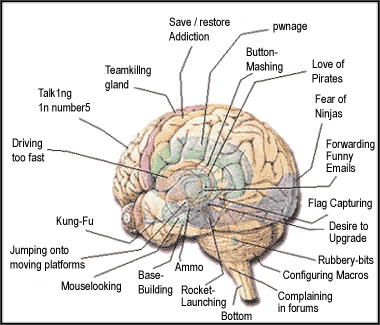Why
do we always have room for dessert? Ever
since Pavlov trained dogs to salivate for meat powder at the sound of a bell,
psychologists have used the principles of classical conditioning to study how
animals and humans learn. But only recently have they been able to peer into the
brain and watch that learning take place.
 Now
Now
a team of English researchers, using a sophisticated brain scanning technique
called functional M.R.I., has provided a vivid demonstration of the neural processes
at work in a simple Pavlovian conditioning experiment.
Like
Pavlov's dogs, the subjects in the study were conditioned to associate a neutral
stimulus — in this case, abstract images presented on a computer screen — with food. One image was paired with the smell of peanut butter, wafted to the
subjects' noses through a tube. Another image was paired with the smell of vanilla.
The
13 subjects, said Dr. Jay A. Gottfried, a postdoctoral fellow at the Welcome department
of neuroimaging science at University College London and the lead author of the
study, "were all young, healthy, right-handed volunteers who came in hungry
and professed to liking both peanut butter and vanilla, which isn't so easy in
England."
The
subjects, who thought they were participating in an experiment about learning
computer tasks, were quickly trained to associate the images with the food smells.
The subjects reacted faster to the images paired with the food odors than to other
images that had no pleasant associations. At the same time, their brains surged
into action, with areas known to be involved in motivation and emotional processing
— the amygdala, deep in the temporal lobe, the orbitofrontal cortex, and
other structures lighting up on the brain scan.
Then
the researchers took their study, published last week in the journal Science,
a step further. When the subjects were fed either a peanut butter sandwich or
a bowl of vanilla ice cream, Dr. Gottfried and his colleagues found, the images
associated with that food no longer drew as strong a response, and the subjects'
emotional brain circuits quieted down. But the image associated with whichever
food the subjects did not receive continued to elicit faster reaction times and
a flurry of chemical activity in the amygdala and other brain areas.
Psychologists
refer to this as "selective satiation." Dr. Gottfried calls it "the
restaurant phenomenon." "You
go out to Lutèce and have an eight-course meal and just when you think
you can't stuff another crumb into your mouth, they bring the dessert cart by
and, miraculously, you have a spot for that chocolate cake," he said.
Whatever
its label, added Dr. Gottfried, who did the study with two other scientists, Dr.
John O'Doherty and Dr. Raymond J. Dolan, the effect reflects the fact that learning
is a tool designed by evolution for survival and as such, is infinitely flexible.
"If you think about a rabbit jumping around a carrot patch," he said,
"it may learn that a pile of rocks comes to predict that carrot patch. But
once the patch is depleted, it behooves the rabbit no longer to follow the promptings
of that pile of rocks."
The
study's findings, he added, may eventually help scientists understand more about
why people with eating disorders fail to become satiated on foods even after they
have eaten them.
Patients
with injuries to the brain's frontal and temporal lobes, Dr. Gottfried noted,
areas that encompass the circuit involved in hunger and satiation, often have
eating problems and may eat indiscriminately or fail to stop eating when they
are full.
But
Dr. P. Read Montague, a professor of neuroscience at the Baylor College of Medicine
and an expert on mental function and the brain, said the study was most noteworthy
for offering a glimpse of what takes place inside the brain when a rat learns
to run a maze or a human to forage for lunch. "This is what psychologists
really couldn't do" before, he said. "They could sit and observe the
behavior, but they couldn't eavesdrop on the black box as they were doing it."

Gottfried
said specific brain circuits are involved in this process. The researchers found
heavy involvement of the amygdala — the area of the brain best known for
processing emotions — and the orbitofrontal cortex. “If every time you
drove past a McDonald’s and saw the golden arches, you felt compelled to
go inside and get a Big Mac, this would be destructive after time,” he said. Something must tell the brain when to respond and when not to, and this does not
necessarily stop at food. “Whether we are talking about food or sex or even
things on the aversive scale such as dangers and threats and predators, the brain
also needs to know how to update ... and modulate these associations so you don’t
get stuck in a rut.”~By
Erica Good, New York Times
https://www.inspirationline.com/Brainteaser/dessert.htm
brain pictures added to this article from the net.
Pardon my light hearted approach to this with the pictures I chose. I thought they did give me a good "picture" of this area and as the last sentence states.. "and modulate these associations so you don’t
get stuck in a rut.”



